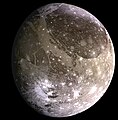Файл:The Galilean satellites (the four largest moons of Jupiter).tif

TIF сығанаҡ файлы өсөн JPG ҡарап сығыу ваҡытындағы күләме: 800 × 262 пиксель. Башҡа айырыусанлыҡтар: 320 × 105 пиксель | 640 × 210 пиксель.
Сығанаҡ файл (1830 × 600 нөктә, файлдың дәүмәле: 1,51 Мб, MIME төрө: image/tiff)
Файл тарихы
Файлдың күрһәтелгән ваҡытта ниндәй өлгөлә булғанын ҡарар өсөн баҫығыҙ: Дата/ваҡыт
| Дата/ваҡыт | Миниатюра | Үлсәмдәре | Ҡатнашыусы | Иҫкәрмә | |
|---|---|---|---|---|---|
| ағымдағы | 17:54, 29 декабрь 2011 | 1830 × 600 (1,51 Мб) | Prof. Professorson | {{Information |Description=This composite includes the four largest moons of en:Jupiter which are known as the Galilean satellites. The Galilean satellites were first seen by the Italian astronomer en:Galileo Galilei in |
Файл ҡулланыу
Был файлды киләһе бит ҡуллана:
Файлды глобаль ҡулланыу
Был файл түбәндәге википроекттарҙа ҡулланыла:
- af.wikipedia.org проектында ҡулланыу
- als.wikipedia.org проектында ҡулланыу
- ar.wikipedia.org проектында ҡулланыу
- ast.wikipedia.org проектында ҡулланыу
- az.wikipedia.org проектында ҡулланыу
- be-tarask.wikipedia.org проектында ҡулланыу
- be.wikipedia.org проектында ҡулланыу
- bg.wikipedia.org проектында ҡулланыу
- bn.wikipedia.org проектында ҡулланыу
- bn.wikibooks.org проектында ҡулланыу
- bs.wikibooks.org проектында ҡулланыу
- ca.wikipedia.org проектында ҡулланыу
- cs.wikipedia.org проектында ҡулланыу
- en.wikipedia.org проектында ҡулланыу
- en.wikibooks.org проектында ҡулланыу
- es.wikipedia.org проектында ҡулланыу
- et.wikipedia.org проектында ҡулланыу
- eu.wikipedia.org проектында ҡулланыу
- fi.wikipedia.org проектында ҡулланыу
- fr.wikipedia.org проектында ҡулланыу
- gl.wikipedia.org проектында ҡулланыу
- he.wikipedia.org проектында ҡулланыу
- hi.wikipedia.org проектында ҡулланыу
- hu.wikipedia.org проектында ҡулланыу
- hy.wikipedia.org проектында ҡулланыу
- id.wikipedia.org проектында ҡулланыу
- it.wikipedia.org проектында ҡулланыу
- ja.wikipedia.org проектында ҡулланыу
- kk.wikipedia.org проектында ҡулланыу
- ko.wikipedia.org проектында ҡулланыу
Был файлды глобаль ҡулланыуҙы ҡарарға.





